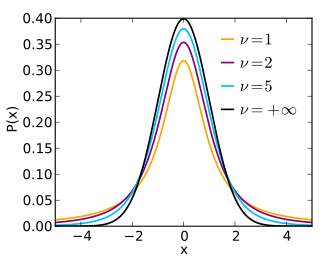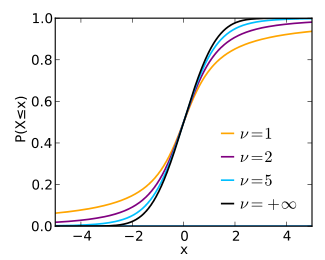Probability distribution
This article is about the mathematics of Student's
t-distribution. For its uses in statistics, see
Student's t-test.
Student's t|
Probability density function  |
|
Cumulative distribution function  |
| Parameters |
 degrees of freedom (real, almost always a positive integer) degrees of freedom (real, almost always a positive integer) |
|---|
| Support |
 |
|---|
| PDF |
 |
|---|
| CDF |
![{\displaystyle {\begin{matrix}\ {\frac {\ 1\ }{2}}+x\ \Gamma \left({\frac {\ \nu +1\ }{2}}\right)\times \\[0.5em]{\frac {\ {{}_{2}F_{1}}\!\left(\ {\frac {\ 1\ }{2}},\ {\frac {\ \nu +1\ }{2}};\ {\frac {3}{\ 2\ }};\ -{\frac {~x^{2}\ }{\nu }}\ \right)\ }{\ {\sqrt {\pi \nu }}\ \Gamma \left({\frac {\ \nu \ }{2}}\right)\ }}\ ,\end{matrix}}}](https://wikimedia.org/api/rest_v1/media/math/render/svg/32b4a3af11d075b054f564e60b7aea14bf2a95f3)
where  is the hypergeometric function is the hypergeometric function |
|---|
| Mean |
 for for  otherwise undefined otherwise undefined |
|---|
| Median |
 |
|---|
| Mode |
 |
|---|
| Variance |
 for for  ∞ for ∞ for 
otherwise undefined |
|---|
| Skewness |
 for for  otherwise undefined otherwise undefined |
|---|
| Excess kurtosis |
 for for  ∞ for ∞ for 
otherwise undefined |
|---|
| Entropy |
![{\displaystyle \ {\begin{matrix}{\frac {\ \nu +1\ }{2}}\left[\ \psi \left({\frac {\ \nu +1\ }{2}}\right)-\psi \left({\frac {\ \nu \ }{2}}\right)\ \right]\\[0.5em]+\ln \left[{\sqrt {\nu \ }}\ {\mathrm {B} }\left(\ {\frac {\ \nu \ }{2}},\ {\frac {\ 1\ }{2}}\ \right)\right]\ {\scriptstyle {\text{(nats)}}}\ \end{matrix}}}](https://wikimedia.org/api/rest_v1/media/math/render/svg/f248820e946d0f06d1d132fb0d1473d3bed1736c)
where
 is the digamma function, is the digamma function, is the beta function. is the beta function.
|
|---|
| MGF |
undefined |
|---|
| CF |
 for for 
|
|---|
| Expected shortfall |

Where  is the inverse standardized Student t CDF, and is the inverse standardized Student t CDF, and  is the standardized Student t PDF.[2] is the standardized Student t PDF.[2] |
|---|
In probability theory and statistics, Student's t distribution (or simply the t distribution)  is
a continuous probability distribution that generalizes the standard normal distribution. Like the latter, it is symmetric around zero and bell-shaped.
is
a continuous probability distribution that generalizes the standard normal distribution. Like the latter, it is symmetric around zero and bell-shaped.
However,  has heavier tails and the amount of probability mass in the tails is controlled by the parameter
has heavier tails and the amount of probability mass in the tails is controlled by the parameter  For
For  the Student's t distribution
the Student's t distribution  becomes the standard Cauchy distribution, which has very "fat" tails; whereas for
becomes the standard Cauchy distribution, which has very "fat" tails; whereas for  it becomes the standard normal distribution
it becomes the standard normal distribution  which has very "thin" tails.
which has very "thin" tails.
The Student's t distribution plays a role in a number of widely used statistical analyses, including Student's t test for assessing the statistical significance of the difference between two sample means, the construction of confidence intervals for the difference between two population means, and in linear regression analysis.
In the form of the location-scale t distribution  it generalizes the normal distribution and also arises in the Bayesian analysis of data from a normal family as a compound distribution when marginalizing over the variance parameter.
it generalizes the normal distribution and also arises in the Bayesian analysis of data from a normal family as a compound distribution when marginalizing over the variance parameter.





![{\displaystyle {\begin{matrix}\ {\frac {\ 1\ }{2}}+x\ \Gamma \left({\frac {\ \nu +1\ }{2}}\right)\times \\[0.5em]{\frac {\ {{}_{2}F_{1}}\!\left(\ {\frac {\ 1\ }{2}},\ {\frac {\ \nu +1\ }{2}};\ {\frac {3}{\ 2\ }};\ -{\frac {~x^{2}\ }{\nu }}\ \right)\ }{\ {\sqrt {\pi \nu }}\ \Gamma \left({\frac {\ \nu \ }{2}}\right)\ }}\ ,\end{matrix}}}](https://wikimedia.org/api/rest_v1/media/math/render/svg/32b4a3af11d075b054f564e60b7aea14bf2a95f3)










![{\displaystyle \ {\begin{matrix}{\frac {\ \nu +1\ }{2}}\left[\ \psi \left({\frac {\ \nu +1\ }{2}}\right)-\psi \left({\frac {\ \nu \ }{2}}\right)\ \right]\\[0.5em]+\ln \left[{\sqrt {\nu \ }}\ {\mathrm {B} }\left(\ {\frac {\ \nu \ }{2}},\ {\frac {\ 1\ }{2}}\ \right)\right]\ {\scriptstyle {\text{(nats)}}}\ \end{matrix}}}](https://wikimedia.org/api/rest_v1/media/math/render/svg/f248820e946d0f06d1d132fb0d1473d3bed1736c)













